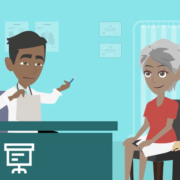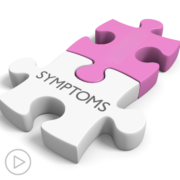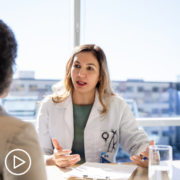Collaborate | Understanding Your Role in Your CLL Care
Collaborate | Understanding Your Role in Your CLL Care from Patient Empowerment Network on Vimeo.
How can chronic lymphocytic leukemia (CLL) patients actively engage in their care? This animated video shares tips and advice for being proactive, including participating in decisions and educating oneself about CLL.
Related Resources:

|

|

|
Transcript:
Dr. Johnson:
Hi! I’m Dr. Johnson, and I’m physician who specializes in blood cancers. And this is Joseph, who is living with chronic lymphocytic leukemia—CLL for short.
And in this series of videos, Joseph and I will discuss steps to help you learn about your diagnosis, understand your treatment options, and collaborate with your healthcare team on CLL care decisions.
Joseph:
And although it may sound simple, collaborating with your team isn’t always second nature.
When I was diagnosed with CLL, I was confused—not only about the disease itself but about MY role in making decisions about my care. I didn’t feel comfortable sharing my opinion or asking questions when I needed more details.
Dr. Johnson sensed my hesitancy and explained to me that educating myself about my CLL would allow me to feel more confident when participating in care decisions.
Dr. Johnson:
Right, Joseph. The first step to feeling comfortable talking with your doctor is to learn about your disease.
You can start with advocacy group websites that have educational resources, such as the Patient Empowerment Network. PEN covers all things CLL—from the basics for newly diagnosed patients to information about cutting-edge therapies.
Joseph:
That’s right! At the advice of Dr. Johnson, I downloaded their office visit planners to help me organize my thoughts and to take notes during my appointments.
Dr. Johnson:
And The Leukemia & Lymphoma Society is another credible place to start. The LLS provides both educational information AND support resources.
Joseph:
You can also ask your doctor for recommendations—or use your patient portal. The portal often contains patient education links and resources.
Dr. Johnson:
But keep in mind that the information you find online is never a substitute for medical advice. Be wary of sites that are opinion-based or focus on one patient’s individual experience.
You should always talk to your doctor about what you’ve learned to get your questions answered.
Joseph:
So true, Dr. Johnson. And once I felt I had a good understanding of CLL, I started to take proactive steps and to participate in my care. Here’s my advice to others:
- First, be sure to write down your questions and goals prior to your appointments. It’s often hard to remember things on the spot.
- Next, bring a loved one along to participate in your appointments and to take notes. It’s a good idea to discuss your takeaways after the visit, too. This will help you retain the information you heard.
- Also, try to get past your fears of “bothering your doctor”—be honest about how you are feeling. It’s especially important to mention any symptoms or side effects because this can have a direct impact on your care. Remember, your doctor can’t troubleshoot an issue unless you tell them what’s going on.
- And if you are taking these steps and still don’t feel like you are being heard—you should consider getting a second opinion or even changing doctors.
Dr. Johnson:
That’s great advice, Joseph—you should always feel like you are at the center of your care. We hope this video inspires you to collaborate in your care.
And, don’t forget to download the resource guide that goes with this video—it provides an overview of the information we covered.
Joseph:
You can also visit powerfulpatients.org/CLL to view more videos with Dr. Johnson and me. Thanks for joining us!
Can Lifestyle or Supplements Impact CLL Treatment Response?
Can Lifestyle or Supplements Impact CLL Treatment Response? from Patient Empowerment Network on Vimeo.
Can chronic lymphocytic leukemia (CLL) patients use supplements or lifestyle changes to impact treatment response? Expert Dr. Danielle Brander shares her perspective and information from other cancer studies.
Dr. Danielle Brander is an Assistant Professor in the Division of Hematologic Malignancies & Cellular Therapy at Duke University Medical Center. Learn more about Dr. Danielle Brander.
Download Resource Guide | Descargar Guía en Español
Related Programs:

|

|

|
Transcript:
Lisa Hatfield:
So we have another patient who is concerned about chances of relapse and is asking if there are any lifestyle changes through diet and supplements or anything that you can speak to that may enhance their response or their duration response to the treatment?
Dr. Danielle Brander:
Yeah. So a very very great question to bring about. And this is the one area, understandably where many of us feel frustrated because we can’t tell patients specifically that this trial has been done and says this specific diet is helpful or this specific lifestyle change is helpful to make the treatment work for longer. I think some of that is because some of the general advice we give meaning maintaining daily activity or a well-balanced diet sound non-specific or simple, but I think do help in patients staying in an overall general health wellness so that they can benefit from the treatment and potentially have less side effects from the therapy.
But getting back to the question we just talked about, I think certainly trials or studies really need to be continuing to look at this, because I think there likely are things that we can be more specific to patients about. There are studies looking at physical fitness and exercise regimens not necessarily specific to CLL, although there are studies being done in that space, but to other cancers showing that physical activity and exercise can help even for patients not on treatment maintain control of their cancer. So general daily activity and exercise are important in studies that look at how do you tailor that to an individual I think are important too.
Share Your Feedback
Create your own user feedback survey
Can CLL Patients Take a Break From BTK Inhibitors?
Can CLL Patients Take a Break From BTK Inhibitors? from Patient Empowerment Network on Vimeo.
Is it possible for chronic lymphocytic leukemia (CLL) patients on BTK inhibitors to take a treatment break? Expert Dr. Danielle Brander shares insight.
Dr. Danielle Brander is an Assistant Professor in the Division of Hematologic Malignancies & Cellular Therapy at Duke University Medical Center. Learn more about Dr. Danielle Brander.
Download Resource Guide | Descargar Guía en Español
Related Programs:

|

|

|
Transcript:
Lisa Hatfield:
So this patient is telling us that he’s trying to plan life while living with cancer. It’s a challenge. It’s hard to know where to start. Can some patients go off of ibrutinib (Imbruvica) after five years and enter a watch-and-wait kind of program? And will they be monitored during that time too, if they ever do go off of the medication?
Dr. Danielle Brander:
Yeah, more excellent, excellent questions. So of those main categories of treatment, the BTK inhibitors are given continuously, meaning, at least so far, the standard way we recommend of those treatments is that they’re taken every day, either once or twice a day, depending on which BTK inhibitor, and they’re taken every day. Unless patients run into progression, meaning the CLL learns to grow through its resistance or patients run into side effects that despite maybe team’s recommendation of changing the dose or holding the medications, that it’s just the medication is just not tolerated.
In those cases, there are cases where we do recommend stopping the treatment because of side effects. And the key there is that patients if depending how long they’ve been on treatment or how their CLL is responding, might not need to go on to the next treatment right away.
So to answer this patient’s question, if they were to run into a side effect that wasn’t manageable, there are patients where we say, stop treatment and let’s just watch things, see if you need treatment, if your CLL has no other reason to jump into the next therapy. And there have been encouraging things that we’re learning and that I think are hopeful to this patient’s question, which is maybe in the future there are patients where we proactively can tell them to stop after a certain time because of what we’ve learned for patients so far.
But at the current moment in time, we don’t tell patients to stop at a certain amount of time. But there are trials that are looking at that after a certain number of years. And there are also trials that have followed patients who have stopped therapy and some of those patients, as I mentioned, who are told to stop treatment due to other side effects or other reasons, may go a long time, a couple of years before they need to start therapy.
Share Your Feedback
Create your own user feedback survey
BTK Inhibitor Treatment Side Effects | What CLL Patients Should Know
BTK Inhibitor Treatment Side Effects | What CLL Patients Should Know from Patient Empowerment Network on Vimeo.
What do chronic lymphocytic leukemia (CLL) patients need to know about BTK inhibitor treatment side effects? Expert Dr. Danielle Brander explains common side effects with BTK inhibitors.
Dr. Danielle Brander is an Assistant Professor in the Division of Hematologic Malignancies & Cellular Therapy at Duke University Medical Center. Learn more about Dr. Danielle Brander.
Download Resource Guide | Descargar Guía en Español
Related Programs:

|

|

|
Transcript:
Lisa Hatfield:
We have a couple of questions about BTK inhibitors, and you already talked a little bit about the role of those and why they’re significant in treating CLL. But another patient’s asking about the, of course, a lot of patients wonder, what are the side effects? They hear chemo and like, “Oh, my gosh, the side effects are going to be off.” Can you talk about the side effects and even maybe some unusual side effects that you’ve heard of from patients when using the BTK inhibitors?
Dr. Danielle Brander:
Sure, absolutely. And so again, really important, these are things that as we maybe anticipate patients are going to start treatment, this is a long discussion of deciding between treatment, for example, as first treatment. There’s no trial saying one path is necessarily better than the other. So we try to individualize choosing between BTK inhibitors or that venetoclax-based therapy I mentioned. Some of that though comes about and what expected side effects are expected side effects for the individual. I try for patients to hear it from myself, other members of the team, the nurse, our pharmacist, for example.
And so patients shouldn’t feel overwhelmed to keep asking about what to expect or new side effects. There are some side effects we talk about regardless of the treatment. So I’ll just point out, anytime you’re starting treatment, you’ll hear the team talk about risk for infection, monitoring for fevers, reaching out to us about those kinds of side effects, lower blood counts that can happen regardless, not specific to BTK though it can happen there as well.
There’s some specifically though with BTK inhibitors, we ask patients to watch out for. Some BTK inhibitors can cause some cardiovascular side effects, meaning watching out for funny beating of the heart or what we call palpitations, skipped beats. There can be arrhythmias, some patients can have with time elevation in their blood pressure, for example. And then risk for bleeding, meaning BTK inhibitors affect how the platelets stick together similar to what aspirin does.
So the platelet levels may be normal but patients might have easier bruising, just generally manageable. But if there’s any kind of bleeding, certainly the team should be aware. It’s also the reason though, if you’re on a BTK inhibitor and you have a planned surgery or procedure, let your team know, because we may recommend or a lot of times recommend holding the medication before and after certain surgeries or procedures.
Other side effects can be muscle or joint aches. Some patients have some gastrointestinal side effects like looser stools or sensitivities to certain food causing looser stools, for example. And then there are some that are specific to the individual BTK inhibitor. This is the one point I’ll mention that first-generation BTK inhibitor ibrutinib, part of the reason for the second-generation zanubrutinib (Brukinsa) and acalabrutinib (Calquence) is not necessarily of them working better but to have less of these side effects that I just mentioned.
Share Your Feedback
Create your own user feedback survey
Chronic Lymphocytic Leukemia Prognosis and Treatment Factors
Chronic Lymphocytic Leukemia Prognosis and Treatment Factors from Patient Empowerment Network on Vimeo.
What do chronic lymphocytic leukemia (CLL) patients need to know about treatment factors and prognosis? Expert Dr. Danielle Brander explains key tests involved in determining CLL treatment and prognosis.
Dr. Danielle Brander is an Assistant Professor in the Division of Hematologic Malignancies & Cellular Therapy at Duke University Medical Center. Learn more about Dr. Danielle Brander.
Download Resource Guide | Descargar Guía en Español
Related Programs:

|

Chronic Lymphocytic Leukemia Research and EVOLVE Trial Updates |

Common Chronic Lymphocytic Leukemia Symptoms and Follow-Up Tests |
Transcript:
Lisa Hatfield:
So, Dr. Brander, how do you explain CLL treatment options and prognosis to your newly diagnosed patients? And I think that the prognosis piece is really important, especially if they do start treatment.
Dr. Danielle Brander:
What are the things we’re looking for in terms of needing treatment? Because some of those, especially the symptoms we’re noting a lymph node or spleen, for example, or symptoms of anemia, which is low red cells or bleeding from low platelets, it’s helpful for patients to understand what we’re looking for, but, of course, in the time between visits those are the things we want to help patients with if they notice.
And so we encourage them all the time to call our triage or send us, you know, most electronic medical records now, have ways to send your team a message. And we want to know about that from patients in between visits. In terms of prognosis, as I mentioned before, there are other CLL-specific labs usually on the blood, meaning a regular blood draw.
Most patients don’t need another lymph node biopsy or a bone marrow biopsy, though that happens in some cases. And two of those or some of those key markers I mentioned before, but they test in the leukemia, there’s one test called the FISH, F-I-S-H, it’s not specific to CLL, we use it in other cancers. But it’s to look for specific changes in the leukemia genomics, meaning the DNA, the genetic material of the leukemia, not genetics you’re born with, but the cancer itself.
And there are specific patterns and that can be helpful as I sit down with patients to say this isn’t 100 percent, but this is kind of what to expect and likelihood of needing treatment over the next couple of years. There’s another test called IGHV, another mutation test TP53 kind of beyond this to go over right now, but as you mentioned, I think it’s important to meet with your medical team and say, ‘How does this pertain to me specifically?”
In terms of prognosis, I think there’s two parts to that of understanding what to expect. There’s likelihood of needing treatment, there’s likelihood of time to treatment, and those kind of markers and staging system help in a good way. Right now, our historical expectations, meaning 5 or 10 years ago, we could often also sit with patients and say, “This is the prognosis in terms of survival.” Expected life expectancy on average, but in a good way, most of our systems nowadays with the newer treatments likely vastly underestimate patient survival, meaning those systems were designed when we only had chemotherapy treatments.
Now, we know patients even with the highest risk markers, the faster progressions are living, you know, years and years beyond what was expected with chemotherapy. So I just caution especially materials around from just a couple of years ago that likely they don’t pertain, but they can be helpful in knowing what to expect.
Share Your Feedback
Create your own user feedback survey
Does CLL Research Show Potential for a Cure?
Does CLL Research Show Potential for a Cure? from Patient Empowerment Network on Vimeo.
Could chronic lymphocytic leukemia (CLL) research potentially bring a cure for patients? Dr. Danielle Brander shares her perspective about the future of CLL care, functional cure, and cure-like condition.
Dr. Danielle Brander is an Assistant Professor in the Division of Hematologic Malignancies & Cellular Therapy at Duke University Medical Center. Learn more about Dr. Danielle Brander.
Download Resource Guide | Descargar Guía en Español
Related Programs:

Chronic Lymphocytic Leukemia Prognosis and Treatment Factors |

Chronic Lymphocytic Leukemia Research and EVOLVE Trial Updates |

Common Chronic Lymphocytic Leukemia Symptoms and Follow-Up Tests |
Transcript:
Lisa Hatfield:
So as a cancer patient, one of the biggest questions I had when I was diagnosed, you hear the word “cancer” or in this case “CLL leukemia.” Two questions. One of them, is there a cure for CLL? And if not, are there any trials looking at a cure for CLL?
Dr. Danielle Brander:
Yes. Excellent. An understandable question. Traditionally, we say that CLL or others slower-growing, or sometimes you’ll hear the term indolent lymphomas, do tend to be slower-growing. Some patients don’t need treatment. But the flip side of that is we generally think of them as not curable, that they’re a chronic condition and that treatment, the goal of treatment is to knock it down and relieve whatever symptoms or indications or reasons your starting treatment are.
But at some level, we historically think of CLL as either eventually coming back or sticking around, so to speak. However, I think most oncologists, most those in the field, feel that some of the treatments that are around or in combination, that we’re going to have some patients that have maybe what a term might be functional cure or individual, cure-like condition.
Meaning if our newer treatments for some patients can knock down the CLL so much that it either doesn’t come back or take so long to even show itself again, in a way that serves as what the purpose of cure, really is, which is to get it down to levels that it’s not causing problems or not coming back, for the lifetime of the patient.
Bone marrow transplant is the only therapy historically that has been cured, has offered a cure for some patients. The downside and the reason that most patients aren’t referred to for bone marrow transplant is the risk side of it. Meaning, unfortunately, a bone marrow or stem cell transplant has such a high risk of directly causing side effects.
That could be life-limiting or chronic side effects from the transplant itself versus the agents available now that we aren’t using or referring to bone marrow transplant nearly as much, but I think it’s really encouraging what we’re seeing in responses. So we talked already about those main categories of BTK inhibitors or venetoclax, I didn’t yet talk about, but there are many trials that have looked at those in combination, or CAR T, for example, or bispecific antibodies that are knocking down the CLL to such low levels. But the hope is that serves as a way of functional cure. But it’s going to take time to see if that’s the case. But we’re all very encouraged and really believe that that’s on the horizon.
Share Your Feedback
Create your own user feedback survey
Chronic Lymphocytic Leukemia Research and EVOLVE Trial Updates
Chronic Lymphocytic Leukemia Research and EVOLVE Trial Updates from Patient Empowerment Network on Vimeo.
What’s the latest in chronic lymphocytic leukemia (CLL) research? Expert Dr. Danielle Brander shares research updates and an update about the EVOLVE trial by the SWOG cooperative group.
Dr. Danielle Brander is an Assistant Professor in the Division of Hematologic Malignancies & Cellular Therapy at Duke University Medical Center. Learn more about Dr. Danielle Brander.
Download Resource Guide | Descargar Guía en Español
Related Programs:

Chronic Lymphocytic Leukemia Prognosis and Treatment Factors |

Common Chronic Lymphocytic Leukemia Symptoms and Follow-Up Tests |
Transcript:
Lisa Hatfield:
Can you talk a little bit about the novel pathways and targets that are currently under investigation in CLL, and what are the most important highlights from those for patients and their families and care partners?
Dr. Danielle Brander:
Yes. So over the last decade or even the last five years, for patients diagnosed with CLL, there’s been a very encouraging and market change in the available treatments that is, you know, not that many years ago we generally only had chemotherapy or chemotherapy combined with these antibody targeted treatments that we call immunotherapy sometimes.
But in the last 5 to 10 years we’ve seen quite a remarkable change in treatments that target, meaning often they go after pathways or ways that the CLL cells have learned to grow or have learned to not die the way that normal cells should, die after certain time points. The two main categories of treatments that are approved for CLL treatment, either for patients as a first treatment or patients that have had treatment before including prior chemo or other agents are called BTK inhibitors or BCL-2 inhibitors.
BTK is something inside the leukemia cells. It’s also in some of our other cells. But in the CLL cells particularly, they’re very sensitive in needing that protein. So in targeting that BTK inhibitors keep the cells from getting the normal signals that they need to stay alive, and so the lymph nodes that are big get smaller, a spleen that might be big get smaller, white count eventually comes back down, for example.
And those BTK inhibitors have also already encouragingly changed over recent years. So there was…you’ll hear people say first generation, these were the first inhibitors that came out, that was a drug called ibrutinib (Imbruvica), which is still around. And then there are second generation that are approved that have come out as first treatment or treatment for previously patients that receive treatment.
Those second-generation BTK inhibitors are called zanubrutinib (Brukinsa) and acalabrutinib (Calquence) that are approved. The main other approved category of these targeted treatments I mentioned is venetoclax based treatment. And that targets something different, that targets a set of proteins inside the cell that tell the cell to stay alive too long. And so you have this accumulation and venetoclax targets that pathway. And the last thing I’ll mention about the BTK inhibitors that’s emerging is now there are trials of what are called non-covalent BTK inhibitors.
So they work in a different way, they go after BTK and so that they can work. The non-covalent, even for patients where the first and second-generation, traditional covalent BTK inhibitors I mentioned stop working, those are not yet approved officially for CLL, though they’re approved in mantle cell lymphoma. That’s a drug called pirtobrutinib (Jaypirca), that’s a non-covalent BTK. And the reason that emerging set of treatment, as I mentioned, is important is because it can work for patients where the first or second-generation covalent BTK inhibitors stop working. The venetoclax (Venclexta), as I mentioned, works by a different mechanism. So patients, of course, where the BTK stopped working, in many cases venetoclax can be helpful as well.
Lisa Hatfield:
So I read a little bit, I did a little research on trials that you’re involved in, and there is a trial the EVOLVE CLL trial, and I wonder if you can talk about that a little bit because I think it is exciting for patients to hear that there might be an option for earlier intervention. And I’m not sure if you’re allowed to talk about any results yet, but if you can speak to results, that would be great to hear about those results too.
Dr. Danielle Brander:
Well, yes and no, thank you for bringing this up because this is very important. As you mentioned, it’s called the EVOLVE study. It’s led by a national cooperative group called SWOG, meaning there are lots of places that it’s available, not just larger centers, but smaller oncology centers as well. And this is to look at what’s called early intervention, meaning as we spoke about before, most patients with CLL don’t need treatment at the time that they’re diagnosed.
The reasons for treatment are, we call those treatment indications are based on three main categories that I’ll just review. For some patients, it’s new or progressive symptoms like weight loss or, very symptomatic limiting life day-to-day activities like night sweats or fatigue, for example, that’s the first category of reasons some patients might need treatment is unmanageable side effects.
The second main category is if the lymph nodes get very large or impacting on organ function, or the same for the spleen, it’s getting very large to a certain size, or it’s affecting your ability to eat regular meals or losing weight. And then the last category of treatment indications that we generally wait to start treatment for are if it’s affecting the normal blood count.
So there’s not one magic white count where patients need to start treatment, but almost like weeds in a garden, if those CLL cells are crowding out the red blood cells, so the hemoglobin’s falling or it’s crowding out the platelets, so the platelets are crowding and can’t grow and reach a certain threshold, then we recommend treatment. Of course, there are scattered other reasons, but those are the main three categories. And the reason of waiting to start until those are met is because historically trials have been done to look at waiting for those indications versus treating around the time of diagnosis.
Those trials so far have included, chemotherapy by itself or chemotherapy in combination. And most recently there was a trial looking at first-generation ibrutinib that was given continuously. And so far there’s been no survival. So no life expectancy benefit to early treatment versus waiting for those indications. And the other reason generally not treating all patients is because some patients never require treatment, about a quarter of patients.
So if we offer treatment to everybody, at the time of diagnosis, there are patients that would get treatment that would be exposed to side effects and never needed. But what the EVOLVE study is uniquely looking at is randomizing. And randomizing means some patients will get treatment and some patients will wait until those traditional reasons to need treatment. But for those randomized to receive therapy, it’s that venetoclax based treatment combined with this antibody called obinutuzumab (Gazyva).
And the way that treatment is given for patients, is the same way it’s given for patients who outside of the trial need treatment, meaning they get the antibody infusion, then they get the venetoclax pill, but it’s for a fixed duration, meaning a total of one year of treatment. The trial is also only for patients with higher-risk CLL. So as I mentioned, some patients never need treatment, some patients do, some patients need it quicker.
So rather than looking at this trial and saying all patients, including those with CLL, that’s likely to be slower-growing. The EVOLVE trial is only for patients who are more likely to need treatment in the next couple of years. And the way that’s determined is a score called the CLL-IPI score, and CLL-IPI tries to identify patients more likely to need treatment in the next couple of years by a couple of key factors.
Stage at the time of diagnosis, it looks at age, and it looks at key factors of the leukemia itself, including something called deletion 17P or TP53, because that marker in the cells is a high risk of eventually needing treatment. So to answer your question, what EVOLVE is looking at is taking higher-risk patients, so patients rather than all patients more likely to need treatment anyway, and around the time of diagnosis, randomizing to either be treated or to follow the traditional, sometimes called watch and wait or dynamic monitoring until they reach traditional markers. And ultimately, and it’ll likely take many years to look at, ultimately the question is looking at if that helps prolong patient survival by having higher-risk patients receive that fixed-duration treatment earlier in time. We don’t yet have any results or any results to share, because the study is still enrolling.
Dr. Danielle Brander:
But again, I think it’s something for patients to be aware of, because it does look at the higher risk patients. But around a year, it has to be within a year of diagnosis. So patients who are newly diagnosed, the question to ask your oncology team is “Do I qualify?” if it’s something you’re interested for, and they’ll help walk you through that. If you haven’t had markers checked, for example, it might be a good time to ask about that, to see if this is something would be available, even if not available though, it does create a time to talk to your team about the markers, because those can inform regardless of trial or not maybe what to expect in coming years and likelihood of treatment.
Share Your Feedback
Create your own user feedback survey
Common Chronic Lymphocytic Leukemia Symptoms and Follow-Up Tests
Common Chronic Lymphocytic Leukemia Symptoms and Follow-Up Tests from Patient Empowerment Network on Vimeo.
What’s important for chronic lymphocytic leukemia (CLL) patients to know about symptoms and follow-up tests? Dr. Danielle Brander explains CLL symptoms and symptoms and tests that can help diagnose or rule out CLL.
Dr. Danielle Brander is an Assistant Professor in the Division of Hematologic Malignancies & Cellular Therapy at Duke University Medical Center. Learn more about Dr. Danielle Brander.
Download Resource Guide | Descargar Guía en Español
Related Programs:

Chronic Lymphocytic Leukemia Prognosis and Treatment Factors |

|

Chronic Lymphocytic Leukemia Research and EVOLVE Trial Updates |
Transcript:
Lisa Hatfield:
I’d like to talk about what’s on the CLL treatment radar. There’s a lot going on in terms of emerging treatment options, clinical trial data, and other learnings from the CLL community. Before we jump into a detailed discussion, can you provide an explanation of what CLL is?
Dr. Danielle Brander:
Absolutely. So CLL, or chronic lymphocytic leukemia, we generally think of as blood cancer. But often as you hear the ending of that, the name leukemia, we also think of it as a lymphoma, meaning patients can have the spectrum of an elevated white count like you might think of in terms of a leukemia. They can also, like a lymphoma though, have enlarged lymph nodes or spleen. And often patients are diagnosed incidentally and that just means that they’re…in seeing their physician or their medical team for other reasons. And they might have had a blood test, and their white count’s elevated. Or they might notice they have a tiny enlarged lymph node or found on screening for other cancers, for example.
And so the takeaway there is that many patients don’t necessarily have symptoms and certainly often many patients don’t have reasons to need to start treatment at the time they’re diagnosed. So in terms of what it is today, I think more and more patients are being diagnosed both because it is something that comes about as patients get older, but also because it’s found during routine other visits. And so more and more patients I think are found incidentally that way.
Lisa Hatfield:
So just a follow-up question to that, if a patient goes into their primary care provider and finds something unusual that might indicate CLL, will they be referred to a hematologist right away at that point? Usually?
Dr. Danielle Brander:
So that is a great question. Often they are, for example, if they’re noted to have a high white count or, specifically a type of white cell called lymphocytes. However, there are many things that can cause that or cause a small lymph node. And so, some primary care appropriately, if those changes are small and they could be due to other things like an infection, for example, then their primary care might want to follow up first. And if things go away, it may not be related to a cancer at all.
But if it’s something that persists or it seems very out of range, or primary care, who, you know, are specialists and seeing kind of changes all the time, and may say this seems a little bit out of range, then even before something’s diagnosed, patients might be referred to a hematologist or an oncologist to help with that workup. But often because primary care is so astute in seeing these things, they may counsel patients to say, let’s send this test or this test to get things going while we’re speaking to a hematologist or oncologist.
Share Your Feedback
Create your own user feedback survey
Why Is Early Stage Chronic Lymphocytic Leukemia Treatment Delayed?
Why Is Early Stage Chronic Lymphocytic Leukemia Treatment Delayed? from Patient Empowerment Network on Vimeo.
What’s the reasoning behind delaying chronic lymphocytic leukemia (CLL) treatment in early stages? Expert Dr. Ryan Jacobs explains results of the CLL12 study and why active surveillance is an approved approach in early stage CLL.
Dr. Ryan Jacobs is a hematologist/oncologist specializing in chronic lymphocytic leukemia from Levine Cancer Institute. Learn more about Dr. Jacobs.
Related Programs:

Can CLL Remission Occur With Rheumatoid Arthritis Drug Treatments? |

|

|
Transcript:
Lisa Hatfield:
Why are CLL patients not getting treatment in early stages of disease?
Dr. Jacobs:
So interestingly enough, in the recently reported final analysis of the CLL12 study, which was trying to look at this particular question, do we, with our newer agents, gain anything from starting treatment earlier? Because, I’ll just remind the audience that there’s never been a study that shows giving an asymptomatic patient chemotherapy, ultimately improves survival. So we don’t do it. And with the important also caveat that I…there is a percentage of CLL patients that will never progress clinically. And I have patients in my clinic that have been on active surveillance for more than two decades.
So, with all that in mind, with our newer treatments, and, of course, ibrutinib (Imbruvica) was the first newer of these targeted agents, these small molecule inhibitors, there was this question, well, now that we have these newer treatments, can we start treatment early and does it make a difference? And so they took high-risk CLL patients and randomly assigned them in a blinded way to placebo or ibrutinib and followed them for years. And they just recently shut down the study because after many years there is still no difference in survival. And, of course, there are side effects with treatment and there’s financial toxicity for treatment too.
So with no survival benefit, we are, in any study in asymptomatic patients, we are not treating asymptomatic patients. And I have patients that experience hearing that in different ways. I would say three-quarters are really happy and love the fact that they can see me in six months to check in. But then there is the percentage that are kind of angry and think that we’re missing the boat here by just watching, so to speak. But the data supports active surveillance.
Share Your Feedback
Create your own user feedback survey
Can CLL Treatment Cause Gastrointestinal Side Effects?
Can CLL Treatment Cause Gastrointestinal Side Effects? from Patient Empowerment Network on Vimeo.
What do chronic lymphocytic leukemia (CLL) patients need to know about gastrointestinal side effects? Expert Dr. Ryan Jacobs explains some common gastrointestinal side effects from treatment and how treatment can be adjusted to decrease severity of side effects.
Dr. Ryan Jacobs is a hematologist/oncologist specializing in Chronic Lymphocytic Leukemia from Levine Cancer Institute. Learn more about Dr. Jacobs.
Download Resource Guide | Descargar Guía en Español
Related Programs:

|

|

Are There Signs of Chronic Lymphocytic Leukemia Progression? |
Transcript:
Lisa Hatfield:
We have several questions from a couple of patients regarding a side effect. So the question, “How long will my side effects of my CLL treatment last? And what can be done to reduce those?” And specifically, a patient is asking if there’s a connection with CLL and gastrointestinal issues?
Dr. Ryan Jacobs:
So all of the treatments, including venetoclax (Venclexta), the BTK inhibitors, will have diarrhea listed as a possible side effect. It’s usually low grade. But generally, I have found the gastrointestinal toxicities abate some over time. So if they are present earlier, if you’re able to stick with therapy, they do tend to get better. For the once daily meds, I encourage those patients to try to take the drug in the evening. The GI tract tends to be less active later in the day, and you can sleep off some of the potential gastrointestinal issues. So I’ve had success there. Sometimes we have to lower the dose to just find the best dose to help mitigate some of these. There’s the antidiarrheals that can help if you need them. Imodium. I had a patient I saw earlier this week that Imodium didn’t really work, but good old Pepto Bismol did the trick from time to time.
So certainly though, if the gastrointestinal issues are significantly affecting quality of life, we need to come up with a new plan, whether that’s reducing the dose or changing to a different option. Specifically, what’s nice about the BTK inhibitors is they all have data that show if you’re having problems with one, you can switch to the other and likely not have the same problem occur. So that’s nice. Have you ever seen any uncharacteristic side effects several times in your practice? Anything really unique? I’m just curious about that.
Yeah. There’s always the patients, they can have a more severe form of maybe, of a more common side effect, like the…we were talking about diarrhea, I’ve had a patient that actually had a difficult time with venetoclax, had difficulties with the stool incontinence. So that was kind of a severe form of that. It wasn’t so much diarrhea that was the problem. But we were able to ultimately mitigate that with a dose reduction. I would say the way, particularly if it’s an unusual side effect, the best thing to do is to take a break. If it’s a serious side effect that needs to be addressed and it’s affecting quality of life or causing problems, take a break from the treatment. If you take a week off these treatments, particularly venetoclax, taking breaks doesn’t matter. We like not to take long breaks with the BTK inhibitors. But if you take a week off, these drugs don’t have very long half-lives. So if the issue is not getting any better and you’ve been off of treatment for a week, it’s unlikely that that issue is coming from the treatment. So that’s a way I try to sort through some…particularly if they’re unusual side effects sometimes. And certainly, if we deem that the issue is connected to the treatment, I’ll usually try lowering the dose before just giving up.
Share Your Feedback
Create your own user feedback survey
CLL and BTK Inhibitor Treatment: What Are the Risk Factors?
CLL and BTK Inhibitor Treatment: What Are the Risk Factors? from Patient Empowerment Network on Vimeo.
What’s important for chronic lymphocytic leukemia (CLL) patients to know when considering BTK inhibitor treatment? Expert Dr. Ryan Jacobs explains some cardiac risk factors with BTK inhibitors and patients who might want to consider other treatment options.
Dr. Ryan Jacobs is a hematologist/oncologist specializing in Chronic Lymphocytic Leukemia from Levine Cancer Institute. Learn more about Dr. Jacobs.
Download Resource Guide | Descargar Guía en Español
Related Programs:

|

|

Are There Signs of Chronic Lymphocytic Leukemia Progression? |
Transcript:
Lisa Hatfield:
So this patient is asking, “For patients who may be eligible for BTK inhibitors, are there specific comorbidities that might contribute to adverse side effects?”
Dr. Ryan Jacobs:
Yeah, so we screen…all BTK inhibitors have some cardiac toxicity. They have been shown with the second-generation BTK inhibitors to have less cardiac toxicity than ibrutinib, specifically atrial fibrillation. So if you have atrial fibrillation, maybe that’s a reason why you might go on venetoclax first as opposed to a BTK inhibitor. But it’s not a contraindication to getting a BTK inhibitor if the atrial fibrillation is under good control. Other cardiac risk factors would include difficult to control hypertension at baseline, or heart failure. These are all things that might make us think twice about using a BTK inhibitor as our first therapy, because venetoclax has no cardiac toxicities.
The other thing to consider is BTK inhibitors all to a degree have, and I describe it to patients, like an aspirin-like effect on the platelets. They do interfere with the platelet binding, which so universally, patients will know to varying levels some easier bruising. And if patients are on, because of say, they’ve had a heart attack in the past and they’re on aspirin at baseline, or what would even be more concerning if they were on a drug like Plavix because they’ve had a stent placed, that would be something that would really concern me and would definitely push me more towards venetoclax (Venclexta), that again, doesn’t have those anti-platelet interactions. Also, patients who are on blood thinners because of a history of blood clot or atrial fibrillation, there is the potential increased risk for bleeding and bruising there as well. None of these are absolute contraindications, they’re just all what goes into the blender, if you will, of putting lots of information in and coming up with the best treatment decision as personalized for the CLL patient. We’re blessed to have multiple options, but it does make it more of a challenge to find the “best” option.
Share Your Feedback
Create your own user feedback survey
CLL Genetic Markers: What Should I Ask About Prognostic Factors?
CLL Genetic Markers: What Should I Ask About Prognostic Factors? from Patient Empowerment Network on Vimeo.
What’s key for chronic lymphocytic leukemia (CLL) patients to know about genetic markers? Expert Dr. Ryan Jacobs explains genetic markers checked in standard CLL testing, questions to ask your doctor, and common treatments used with specific genetic markers.
Dr. Ryan Jacobs is a hematologist/oncologist specializing in Chronic Lymphocytic Leukemia from Levine Cancer Institute. Learn more about Dr. Jacobs.
Download Resource Guide | Descargar Guía en Español
Related Programs:

|

|

|
Transcript:
Lisa Hatfield:
“How can I ask my doctor to make sure I am being tested for serum markers?” And more broadly, I think a lot of patients are a little bit nervous about asking questions of their doctor, because they don’t want to feel like they’re questioning their expertise or doubting them. So how in general can we ask our doctor questions if we hear something? Or how can we approach our doctor with those types of questions?
Dr. Ryan Jacobs:
So I mentioned asking your doctor, “What’s my prognostic markers?” I think is probably the easiest way to get that information. And your doctor should be checking those. The question comes up like, what are the “high-risk” markers? We talked about mutated versus unmutated. Thankfully, our novel treatments, that doesn’t seem to matter. Same goes with…there’s on FISH there used to be, if you found three copies of chromosome 12, that’s called trisomy 12, that doesn’t seem to matter with our newer treatments. A deletion at chromosome 11, again, used to not do as well with chemo. Novel therapies, doesn’t seem to matter.
The one that is still potentially affecting outcomes, even with our novel treatments, are chromosome 17 aberrations, which stately are rare in the initial diagnostic setting, that or a TP53. A deletion at 17p or TP53 mutation probably is only going to be around 10 percent of patients or so. And in the relapse setting though, that number goes up because of the more aggressive cancers emerge, we call that clonal evolution. So maybe in the 20-ish percent range. These patients, we tend to prioritize indefinite therapies first, because it seems like these patients do better if you keep treatment going, as opposed to interrupted therapies like venetoclax (Venclexta). And so we tend to treat those patients with a drug like acalabrutinib (Calquence) or zanubrutinib (Brukinsa) first and then think about the venetoclax later for those patients.
Lisa Hatfield:
Okay. Okay. And just to clarify, for patients too, I know that a lot of cancers, there are discussions about the 17 deletion, 17p, and then also the TP53 gene. So if I understand correctly, the TP53 gene is housed on chromosome number 17. So if that is missing, then that patient may be missing that gene, that is it considered a tumor suppressor gene, which we want. Is that correct?
Dr. Ryan Jacobs:
Right. So it’s either missing, which is what we see on FISH with a deletion, or it can be mutated and that’s the next gen sequencing, and often it will be both in those patients. We think with indefinite, there’s some really good data that was just released with zanubrutinib. When they looked at 17p-deleted patients, there’s some long-term follow-up with ibrutinib-treated 17p-deleted patients. With chemo these patients would only get about a year or so, but we’re getting maybe even close to normal outcomes with long-term BTK. But we do know if you just give them a year of venetoclax and obinutuzumab (Gazyva) for six months and then stop, they do relapse quicker than the other patients. So they relapse after about four years. As opposed to with five years of follow-up with that first-line venetoclax approach, there are 62 percent of patients who are still free of progression.
Share Your Feedback
Create your own user feedback survey
CLL & Relapse: A Look at Available Treatment Options
CLL & Relapse: A Look at Available Treatment Options from Patient Empowerment Network on Vimeo.
What chronic lymphocytic leukemia (CLL) treatment options are available for relapsed patients? Expert Dr. Ryan Jacobs explains options for patients in relapse and for those seeking additional treatments.
Dr. Ryan Jacobs is a hematologist/oncologist specializing in Chronic Lymphocytic Leukemia from Levine Cancer Institute. Learn more about Dr. Jacobs.
Download Resource Guide | Descargar Guía en Español
Related Programs:

|

|

|
Transcript:
Lisa Hatfield:
What treatments do you think are the most beneficial for patients whose CLL has relapsed? What are the poor prognostic indicators for CLL? And along the same lines, what are the high-risk genetic markers for CLL?
Dr. Ryan Jacobs:
It’s a little more complicated discussion in the first-line setting because both are options. At this point in time, we haven’t been…at least those that are, I would say, staying up to date on the CLL data, we have not been using chemotherapy for a long time. So most of the relapsed patients will have seen either one of the BTK inhibitors or venetoclax (Venclexta). And so what we do in the second-line setting is just use the other option that they haven’t seen. The data tells us, when you look at what treatments are being prescribed, most patients are going on BTK inhibitors, and they have been around longer than venetoclax in general. So for a lot of patients, that relapsed treatment is going to be venetoclax. Because that has the best data in terms of treating patients that have progressed on a BTK inhibitor like ibrutinib (Imbruvica) or acalabrutinib (Calquence) or zanubrutinib (Brukinsa).
In the near future, we’ll have pirtobrutinib (Jaypirca) and so maybe, maybe some will get that drug before venetoclax, and that’s probably okay. And so we’ll have that additional option. The complicated patients, and I’ve alluded to this, or what do we do after BTK and Bcl-2? What are we left with? I mentioned PI3 kinase, that’s not a great option. There’s still stem cell transplant out there for young patients that are running out of options. Clinical trial is really what I would like to emphasize there. If you’re a patient that can get to a high volume referral cancer center with a CLL specialist, I would do that if you have seen BTK inhibitors and venetoclax and are looking for other options.
Share Your Feedback
Create your own user feedback survey
Concerned About CLL Watch and Wait? Start Here
Concerned About CLL Watch and Wait? Start Here from Patient Empowerment Network on Vimeo.
What do chronic lymphocytic leukemia (CLL) patients need to know about watchful watching? Expert Dr. Ryan Jacobs explains the CLL tests and symptoms he monitors during watch and wait or active surveillance.
Dr. Ryan Jacobs is a hematologist/oncologist specializing in Chronic Lymphocytic Leukemia from Levine Cancer Institute. Learn more about Dr. Jacobs.
Download Resource Guide | Descargar Guía en Español
Related Programs:

|

|

|
Transcript:
Lisa Hatfield:
So I just want to take a step back and kind of looking at this through the lens of a newly diagnosed CLL patient. You’d mentioned that sometimes you don’t treat every CLL patient. So is there something, if you find a patient who does not need treatment, is there something you tell the patients as far as regular monitoring? Will you monitor them to see if it progresses to the point where it requires treatment?
Dr. Ryan Jacobs:
Yeah. And we’re fortunate that this is a blood cancer that most of the time we can follow with a simple blood count and follow the white count, follow how the…follow the health of the bone marrow by looking at things like anemia, low red cell count, or a low platelet count that we call thrombocytopenia.
So that’s the easiest thing to follow, but I’m also talking with my patients and examining my patients. I want to know if their lymph nodes are causing them a lot of pain, because we should treat that, there’s no reason they should live in pain. I want to know if they’re waking up drenched in sweat all the time, if their quality of life has been really affected by that or a dramatic amount of fatigue that we can’t explain by some other cause. And I also, of course, examine the nodes myself and make sure that there are no alarming findings there. So that’s really what’s involved with checking on a CLL patient that’s on active surveillance, that’s what we call it. And there’s a list of criteria that the oncologist should know in terms of deeming who needs treatment and who doesn’t. And so we’re kind of following the same rules, so to speak, in terms of who gets treated for CLL.
Share Your Feedback
Create your own user feedback survey



